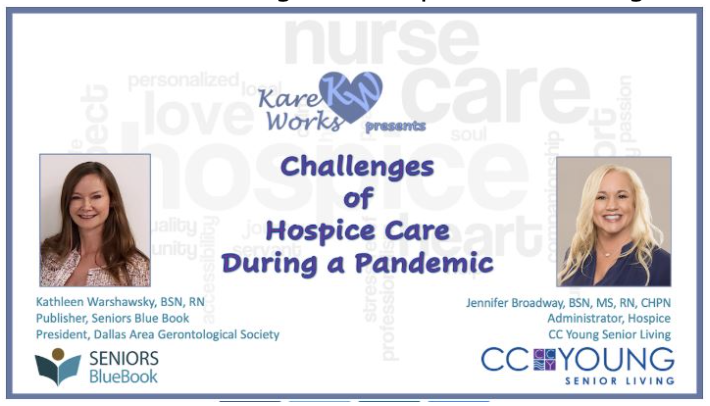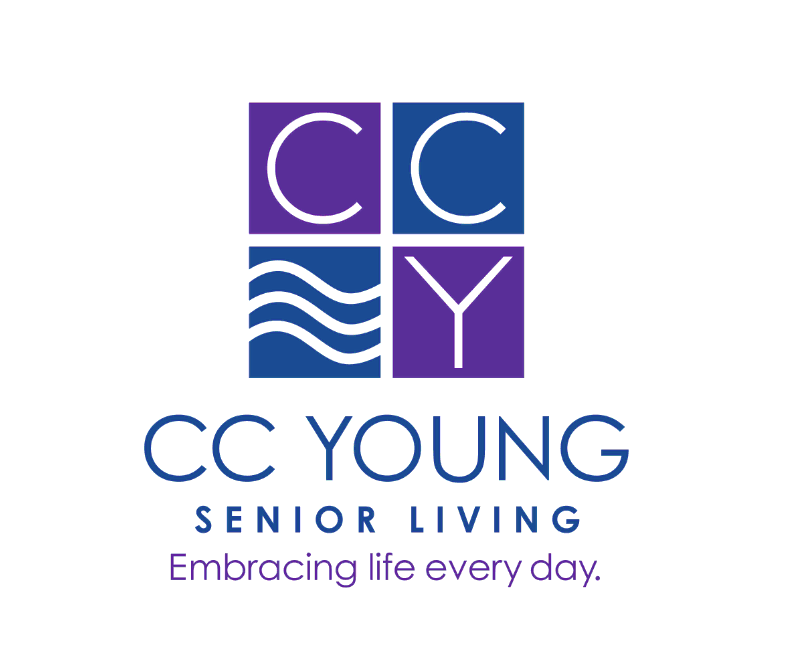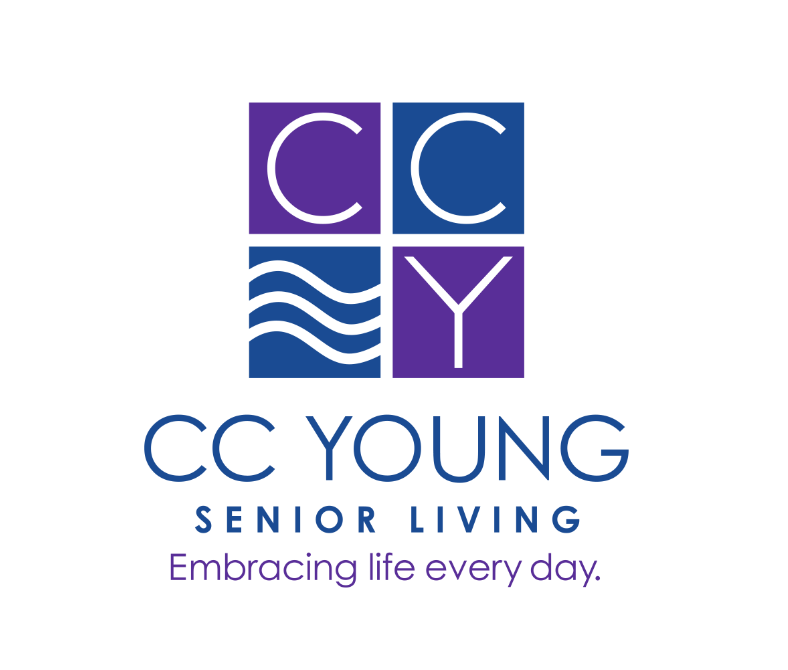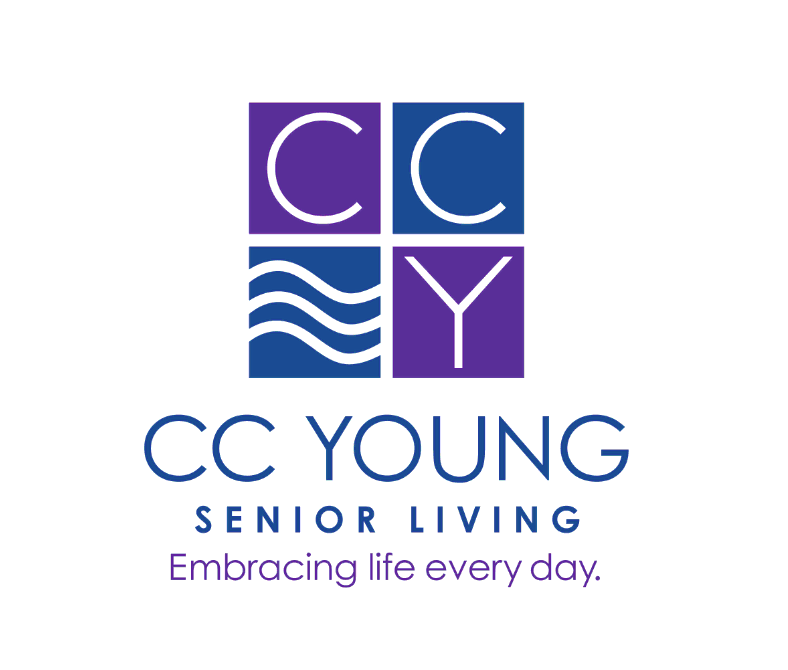Webinar | Challenges of Hospice Care During a Pandemic
CC YOUNG
For more information about the author, click to view their website: Prominent Hospice
Jul 01, 2020
Texas - Dallas, Collin, SE Denton & Rockwall Counties
Email US
Click to Email UsJennifer Broadway, BSN, MS, RN, CHPN Administrator, Hospice at CC Young presents on some of the challenges of hospice care during this COVID-19 pandemic.
Learn how to stay safe and keep your patients safe during a pandemic by following the CDC guidelines. You will also learn how to conduct virtual visits and operations for a hospice team while there are so many restrictions in place by CMS (current for 6/25/2020).
Learning goals for this program include:
Identify safety protocols for staff, facilities, patients and families during COVID-19
Describe challenges of hospice care in both the home and facility settings during a pandemic
Understand how to satisfy the COPs in a virtual environment
The event was hosted by Kare Works and Kathleen Warshawsky, BSN, RN with Seniors Blue Book.
Click to watch the video.
Learn more about CC Young Senior Living | PHONE(214) 305-9662
Other Articles You May Like
Managing Parkinson's Symptoms at Home
Managing Parkinsons Symptoms at HomeThis article is part of The Parkinsons Care Compass, an educational series from At Your Home Caregiving of Texas. Managing Parkinsons symptoms at home takes preparation, compassion, and the right support and we are honored to guide families every step of the way.Managing Parkinsons disease at home requires a careful balance of patience, knowledge, and proactive strategies. Parkinsons affects not only mobility but also speech, mood, memory, and overall daily living activities. As symptoms progress, the home environment and caregiving approach must evolve to meet new challenges and ensure that the individuals dignity, comfort, and independence are preserved.At Your Home Caregiving of Texas specializes in providing customized home caregiving solutions that empower families to manage Parkinsons symptoms effectively while preserving the quality of life for their loved ones.The Importance of a Symptom Management PlanParkinsons symptoms are highly individual no two people experience the disease in exactly the same way. Creating a personalized symptom management plan is essential to addressing the patients physical, cognitive, and emotional needs.A well-rounded plan typically addresses: Mobility and fall prevention Medication management Cognitive and emotional changes Speech and swallowing difficulties Nutrition and hydration Daily routines and activities for mental and physical engagement At Your Home Caregiving of Texas helps families design care plans that respond to their loved ones unique symptoms, preferences, and goals.Mobility Challenges and Fall PreventionMobility issues are among the most recognizable symptoms of Parkinsons disease. Slowed movements (bradykinesia), stiffness, and balance problems increase the risk of falls and injuries.Strategies for Safer Mobility: Home Modifications: Remove trip hazards (like loose rugs), install grab bars in bathrooms, and ensure adequate lighting throughout the home. Use of Assistive Devices: Canes, walkers, and specially designed furniture can aid in safe movement. Clear Walking Paths: Maintain wide, unobstructed paths through frequently used areas like bedrooms, bathrooms, and kitchens. Encouraging Movement Techniques: Techniques like "freezing" drills and cueing strategies (using rhythmic music or counting steps) can help when patients feel stuck or rigid. At Your Home Caregiving of Texas caregivers are trained in fall prevention and can assist clients safely with standing, walking, and transferring from beds or chairs.Medication Management at HomeStrict adherence to medication schedules is critical in Parkinsons care. Medications like levodopa/carbidopa must be taken precisely to control motor symptoms and prevent sudden worsening.Medication Management Tips: Use pill organizers clearly labelled with times of day. Set alarms or use medication reminder apps. Keep a written medication schedule visible for caregivers and family members. Monitor for side effects like dizziness, hallucinations, or sudden involuntary movements (dyskinesias). Our professional caregivers ensure that medication regimens are followed accurately, reducing the risk of complications and hospitalizations.Addressing Cognitive and Emotional ChangesCognitive changes such as memory loss, slowed thinking, and difficulty concentrating are common in Parkinsons, especially as the disease progresses. Emotional changes, including depression and anxiety, may also develop.Support Strategies: Cognitive Engagement: Activities like puzzles, reading, and conversation help keep the mind active. Routine and Structure: A consistent daily routine minimizes confusion and frustration. Patience and Understanding: Allow extra time for decision-making and avoid rushing tasks. Mental Health Support: Professional counselling and medication management can help address depression and anxiety. At Your Home Caregiving of Texas, we prioritize emotional support alongside physical care, creating a nurturing environment for both the patient and their family.Managing Speech and Swallowing DifficultiesSpeech difficulties (dysarthria) and swallowing problems (dysphagia) are common but manageable aspects of Parkinsons.Tips for Speech Challenges: Encourage slow, deliberate speech. Use voice exercises, sometimes under the guidance of a speech therapist. Practice reading aloud or singing to strengthen vocal muscles. Tips for Swallowing Challenges: Consult a speech-language pathologist for swallowing assessments. Offer smaller, more frequent meals. Use thickened liquids if needed to prevent choking. Monitor for signs of aspiration, such as coughing during meals. Our caregivers are trained to notice changes in speech and swallowing and can assist with appropriate interventions to maintain safety and nutrition.Nutrition, Hydration, and ExerciseProper nutrition and hydration are vital for maintaining strength, energy, and medication effectiveness. Constipation, a common non-motor symptom of Parkinsons, can often be alleviated through diet.Key Nutrition Strategies: Focus on fiber-rich foods (vegetables, fruits, whole grains). Maintain hydration offer water throughout the day. Time protein intake carefully, as large amounts of protein can interfere with medication absorption (consult with a physician or dietitian). Incorporate antioxidant-rich foods to support brain health. The Role of ExerciseExercise is one of the most powerful non-medication tools for managing Parkinsons symptoms. Regular movement improves: Balance and gait Flexibility and strength Mood and cognitive function Simple exercises like walking, gentle stretching, yoga, and chair exercises can make a significant difference. Specialized programs like Parkinsons-specific boxing or dance classes can also offer tremendous benefits.At Your Home Caregiving of Texas, our caregivers incorporate gentle movement and stretching routines into the daily care plan, promoting physical vitality and emotional well-being.Creating an Emotionally Supportive Home EnvironmentBeyond managing symptoms, creating a positive and emotionally supportive home environment is essential.Key Elements: Respect and Dignity: Involve the patient in decision-making whenever possible. Companionship: Regular conversation, laughter, and shared activities prevent isolation. Patience and Flexibility: Parkinsons symptoms can vary from day to day caregivers must adapt with grace and understanding. Empowerment: Focus on what the patient can do, not what they cant. Celebrating small victories boosts confidence. Families often find it overwhelming to balance these emotional needs with the physical demands of caregiving. Thats where trusted professional caregivers make a tremendous difference.How At Your Home Caregiving of Texas Supports In-Home Parkinsons CareOur specialized Parkinsons care services are designed to ease the burden on families while maximizing the comfort and independence of the individual living with the disease.Our Parkinsons Home Care Includes: Assistance with personal care, mobility, and safety Medication management and reminders Nutrition support and meal preparation Exercise encouragement and participation Cognitive stimulation activities Emotional support and companionship Home safety evaluations and fall prevention Coordination with therapists, physicians, and family members Every care plan is customized, compassionate, and flexible evolving as the patients needs change over time.Final ThoughtsManaging Parkinsons symptoms at home is both an art and a science. It requires deep understanding, careful planning, and a loving, patient approach. With the right tools, support systems, and caregiving partnerships, families can help their loved ones live meaningful, dignified lives at home for as long as possible.At Your Home Caregiving of Texas is honored to be a trusted partner in this journey. Our expertise in Parkinsons care, our compassionate caregivers, and our commitment to excellence ensure that families receive the support they need, every step of the way.If you are caring for a loved one with Parkinsons disease, reach out to us today. Together, we can build a personalized care plan that brings peace of mind, safety, and hope into your home. At Your Home Caregiving of Texas is committed to helping families manage Parkinsons symptoms at home with expertise, compassion, and customized support. To learn more about creating a safe, empowering home environment for your loved one, explore the Parkinsons Care Compass series or contact us today. Together, we can make every day safer, stronger, and filled with possibility.Contact us at 469-830-8414
Understanding Hospice Care in Western Slope, Colorado: Compassionate Support for Families
When faced with the difficult decision of caring for a loved one at the end of their life, many families in Western Slope, Colorado, turn to hospice care for comfort and support. Hospice care is designed to provide compassionate, specialized care for individuals in the final stages of a terminal illness. This service offers not only physical care but also emotional, spiritual, and psychological support for both patients and their families.What is Hospice Care?Hospice care focuses on improving the quality of life for individuals with a terminal illness rather than attempting to cure the illness. The goal of hospice is to ensure comfort, manage symptoms, and provide dignity for individuals at the end of life. The care team often includes doctors, nurses, social workers, counselors, chaplains, and trained volunteers.Unlike traditional medical treatments aimed at curing an illness, hospice care shifts the focus toward relief from pain and symptoms, allowing patients to live their final days in comfort and peace. Hospice can be provided at home, in a hospice facility, or within a hospital setting, depending on the patient's needs.Why Choose Hospice Care?Hospice care offers numerous benefits, especially for families seeking a holistic approach to end-of-life care. Some key advantages include: Comfort and Pain Relief: Hospice care ensures that patients are as comfortable as possible, providing pain relief through medications and alternative therapies. Emotional Support: Beyond physical care, hospice provides counseling and emotional support for patients and their families, addressing the mental and emotional toll of end-of-life issues. Spiritual Care: Hospice respects the spiritual beliefs of individuals and their families, offering spiritual support as part of holistic care. Care for the Family: The care team supports not only the patient but also the family, offering respite, counseling, and guidance on how to cope with the transition. 24/7 Care Availability: Hospice care offers the advantage of being available around the clock, giving families peace of mind knowing support is always accessible. Hospice Care in Western SlopeWestern Slope, Colorado, is home to numerous hospice providers that specialize in delivering personalized care. Whether you are in Grand Junction, Montrose, or another part of this beautiful region, there are hospice services that cater to the specific needs of the community.Many of these providers offer a range of services, including home hospice care, inpatient hospice care, and even pediatric hospice care. In addition to medical care, many hospice programs in Western Slope emphasize providing services that address emotional and spiritual well-being during this sensitive time.For those who need to learn more about available options in Western Slope, the Seniors Blue Book is an excellent resource for finding hospice providers in the area.How to Find Hospice Services in Western SlopeWhen considering hospice care, its important to explore all the options available to ensure that your loved ones needs are met. The Seniors Blue Book offers a comprehensive directory of trusted hospice providers in the Western Slope region, providing essential information about the services available.You can explore local providers and find detailed information on available services by visiting our directory:Explore hospice care options in Western SlopeDiscover other senior care resources in Western SlopeFinal ThoughtsHospice care is a vital resource for families facing end-of-life decisions. It allows families in Western Slope to ensure that their loved ones receive compassionate care, comfort, and dignity in their final days. By providing physical, emotional, and spiritual support, hospice care offers a holistic approach to managing this challenging time. If you are considering hospice care for a loved one, take the time to explore all the available resources in Western Slope, Colorado, to ensure you choose the best provider for your familys needs.
Understanding Hospice Care in Utah: Support, Compassion, and Dignity at Lifes Final Chapter
When facing the final stages of a serious illness, families in Utah often seek compassionate and expert care that supports both their loved one and the entire family unit. Thats where hospice care becomes an invaluable resource.Hospice services in Utah provide specialized care for individuals who are nearing the end of life. More than just a healthcare service, hospice focuses on comfort, dignity, and emotional supportallowing people to spend their remaining time on their own terms and in peace.What Is Hospice Care?Hospice is a type of end-of-life care for people with terminal illnesses, typically when curative treatment is no longer the focus. Care is centered around comfort, symptom management, emotional support, and quality of life, rather than trying to cure the illness.Care is usually provided wherever the patient calls homewhether thats a private residence, a nursing facility, or an assisted living community. Hospice can also be delivered in dedicated hospice centers for those who require more intensive medical care.Key Services Offered by Hospice Providers in UtahIn Utah, hospice providers follow best practices and compassionate models of care to ensure that patients and families are supported every step of the way. Common services include:Pain and symptom managementMedical equipment and medication deliveryEmotional and spiritual support24/7 on-call nursing assistanceGrief counseling for familiesVolunteer support and companionshipThe care team typically includes physicians, nurses, social workers, spiritual counselors, and trained volunteers who work collaboratively to meet the patients physical and emotional needs.Why Hospice Is Important in UtahUtah has a growing senior population, and with it comes a rising need for holistic care that respects personal wishes at the end of life. Many Utah families value faith, community, and connection, all of which are integral aspects of hospice care.Additionally, many families in Utah appreciate the flexibility and in-home options that hospice offers. These services allow patients to remain in familiar surroundings while receiving professional care that relieves suffering and enhances dignity.Who Qualifies for Hospice Care?Hospice care is typically recommended for individuals with a life expectancy of six months or less, as certified by a physician. This may include individuals with:CancerHeart failureChronic obstructive pulmonary disease (COPD)Dementia or Alzheimers diseaseAdvanced kidney or liver diseaseOther terminal conditionsThe goal is not to hasten death or prolong life unnaturallybut to support comfort, peace, and family presence during a deeply personal time.How to Find Hospice Services in UtahIf youre seeking hospice in Utah, its important to explore your options carefully. Every familys needs are unique, and selecting the right hospice provider can make a meaningful difference in your loved ones experience.To browse trusted providers and services in your area, explore these local resources:Utah Home Health Directory Seniors Blue BookUtah Hospice Services DirectoryThese directories offer a neutral, comprehensive list of options across Utah to help families make informed, compassionate choices without the pressure of advertising or sponsorship.Questions to Ask When Evaluating a Hospice ProviderWhen choosing hospice care, ask the following questions:What services are included and what support is offered to families?How quickly can care begin after referral?Are there specialized programs for dementia, veterans, or pediatric care?Is 24/7 support available for emergencies or concerns?How are care plans created and reviewed?Clear communication and a team-oriented approach are essential hallmarks of a quality hospice provider.The Role of Hospice in Supporting FamiliesWhile hospice focuses on the comfort of the patient, it also plays a critical role in supporting caregivers and families. From education and emotional support to grief counseling, hospice helps loved ones feel less alone during one of lifes most difficult journeys.In Utahs close-knit communities, the family-centered nature of hospice resonates deeplyallowing family members to participate in caregiving while still receiving professional backup and respite when needed.Conclusion Choosing hospice care is a deeply personal decisionone that reflects love, compassion, and the desire for dignity in lifes final chapter. For families in Utah, understanding what hospice offers and how to access care can provide peace of mind and much-needed support.
Local Services By This Author
CC Young Hospice Care Dallas
Hospice 4847 W Lawther Dr, Dallas, Texas, 75214Our Hospice team is gentle, skilled, compassionate, knowledgeable, strong, and calming. At end-of-life, you, your family or your loved one can choose a special kind of support. Hospice care is a benefit paid by Medicare/Medicaid and includes many services like pain and symptom management. We serve 13 counties.
CC Young Independent Living
Independent Living 4847 W Lawther Dr, Dallas, Texas, 75214Experience the convenience of a carefree lock and go lifestyle on our beautiful 20-acre campus nestled within a residential neighborhood across from White Rock Lake. Explore new opportunities - fun events, interesting groups and clubs, and wellness classes on campus. Not to mention, making new friends. We invite you visit and experience CC Young.
Private Care Solutions by CC Young
Non-Medical 4847 W Lawther Dr, Dallas, Texas, 75214Private Care Solutions by CC Young. If you need a little support or assistance to make things easier. We are here with a full range of private pay services, to offer you more freedom to live in your home more comfortably. Whatever your needs are, your Private Care Coordinator will tailor a plan especially for you. Our licensed Private Care caregivers are available to individuals wherever they call home on or off campus. 5-DAY POST DISCHARGE PROGRAMOur Private Care Team is here to help you or your loved one adjust after leaving a hospital or rehab facility. In only 5 days, there are so many ways we can support you:Meet you at home and help you settle inAssist with activities of daily livingPick up medications from your pharmacySet up your medications for youPick up groceriesPrepare mealsSchedule your follow-up appointment with your doctorProvide a report to your physician with 5-day post discharge resultsASSISTANCE WE CAN PROVIDECompanionship and ConversationWake-up/Morning Care and Tuck-in/Evening CareBathing/Dressing/GroomingWalking/Mobility AssistancePlanning, Preparing and Cleanup of MealsLaundryPet CarePreparation and Shopping for GroceriesPersonal CareProviding Medication RemindersArranging AppointmentsTransportation and Companionship to AppointmentsPicking up PrescriptionsWeekly Medication SetupsAdvocating with other Support Services and Healthcare ProfessionalsTechnology (Phones, Computers, TV)Fitness and WellnessHome Safety AssistanceLicensed Nursing VisitsOther Items Per Request



